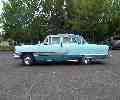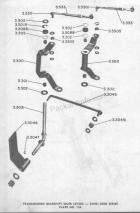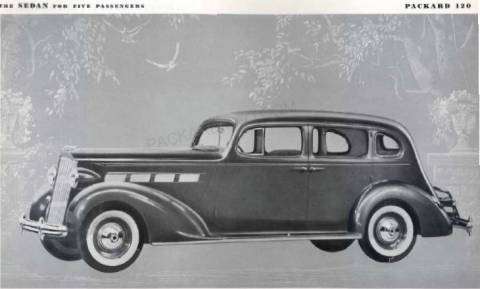|
Re: Easamatic Rebuild Sources
|
||||
|---|---|---|---|---|
|
Home away from home

|
Re: 58 BTV no relief port;
I'm guessing that the master cyl piston has a flat or some other form of a relief cut into it about 1\2 inch from the inner end of the piston.
Posted on: 2013/8/15 18:59
|
|||
|
VAPOR LOCK demystified: See paragraph SEVEN of PMCC documentaion as listed in post #11 of the following thread:f
packardinfo.com/xoops/html/modules/newbb/viewtopic.php?topic_id=7245 |
||||
|
||||
|
Re: Easamatic Rebuild Sources
|
||||
|---|---|---|---|---|
|
Home away from home
|
I am tempted to say much more, but I will restrain myself and say only don't do that.
Having fluid at atmospheric pressure on one side of a seal does not constitute a "strain" on a seal. Check out any engineering handbook about seals. Your unit is worn out; the seals are shot and not sealing. The piston may or may not have pits on it. There is dirt that can hold the compensator open. Have someone rebuild it. Uninformed speculations about modifications to a safety item may lead someone else to do something that will lead to tragedy.
Posted on: 2013/8/16 6:29
|
|||
|
||||
|
Re: Easamatic Rebuild Sources
|
||||
|---|---|---|---|---|
|
Home away from home
|
I second Ross.
Tom
Posted on: 2013/8/16 6:51
|
|||
|
||||
|
Re: Easamatic Rebuild Sources
|
||||
|---|---|---|---|---|
|
Home away from home

|
Just get it rebuilt and be safe.
Posted on: 2013/8/16 7:59
|
|||
|
||||
|
Re: Easamatic Rebuild Sources
|
||||
|---|---|---|---|---|
|
Home away from home

|
Reading this thread made me curious so I dug out my spare BTV unit that cane from a 55 that was parked in 66 with a blown engine. First, the gasket blocked about half the relief port with "staining" above it on the inside of the lid, Second, the port it"s self was clogged near the bottom and looked like it had been blocked for a long time. I understand the dangers of modifying - especially sonething as important as brakes so I'll put it this way: Why was the port opening made level with the top of the resesevior instead kept lower as per the earlier ones?
Posted on: 2013/8/17 14:24
|
|||
|
1951 200 Deluxe Touring Sedan
1951 200 Deluxe Touring Sedan (parts ?) 1951 Patrician Touring Sedan 1955 Patrician Touring Sedan |
||||
|
||||
|
Re: Easamatic Rebuild Sources
|
||||
|---|---|---|---|---|
|
Forum Ambassador
|
I'd bet the early ones tended to slosh over particularly if the reservoir was filled to the brim and the car did any quick motions. I believe the low port was only on the first version & before long Bendix changed the port and the lid so the opening would be higher. On those the fluid would need more force to get up and over & then down inside.
That stamped bubble passage lid in post 38 is the first of that type I've ever seen on a Packard but was on other cars. I've only seen the totally flat lids on Packards. One thing I'd be curious about is how many gasket types were available. I know other cars used various version flat lids at least from the outside appearance -- but were they all perfectly flat inside like Packards -- and did they all use the same type newer gaskets or keep using the earlier gaskets designed for flat lids.
Posted on: 2013/8/17 14:58
|
|||
|
Howard
|
||||
|
||||
|
Re: Easamatic Rebuild Sources
|
||||
|---|---|---|---|---|
|
Home away from home

|
Quote:
" it"s self was clogged near the bottom and looked like it had been blocked for a long time." Is that to mean that it was deliberately plugged or just clogged dedris due to age mileage and use ?????
Posted on: 2013/8/17 15:15
|
|||
|
VAPOR LOCK demystified: See paragraph SEVEN of PMCC documentaion as listed in post #11 of the following thread:f
packardinfo.com/xoops/html/modules/newbb/viewtopic.php?topic_id=7245 |
||||
|
||||
|
Re: Easamatic Rebuild Sources
|
||||
|---|---|---|---|---|
|
Home away from home

|
Posted on: 2013/8/17 15:24
|
|||
|
VAPOR LOCK demystified: See paragraph SEVEN of PMCC documentaion as listed in post #11 of the following thread:f
packardinfo.com/xoops/html/modules/newbb/viewtopic.php?topic_id=7245 |
||||
|
||||
|
Re: Easamatic Rebuild Sources
|
||||
|---|---|---|---|---|
|
Home away from home

|
Quote:
Ross, Point taken. I'm not waffling on getting it rebuilt, just trying to learn as much as I can in the process and share the information. Everything I've presented so far has been, I think, in the form of query, and not any kind of endorsement of a particular view, especially pertaining to modifications of any type. I did want to post my "temptation" to plug the port during the rebuild in order to elicit responses. I will be more careful in future to emphasize that I am bringing up points for discussion. Remember my creed: "I am not an expert." One observation: I don't think that the fluid up against the seals is at onlyy atmospheric pressure when the brake pedal is released, because of the vacuum present at the back side of the seals. Else, how would enough fluid be drawn into the vacuum side quickly enough to cause it to go directly to the intake manifold in quantities large enough to produce smoke for an extended period? I can't claim to know for sure whether the smoking starts upon release of the pedal but I'm pretty sure this is the case. I'm wondering if, once the process of "sucking" begins, repeated application and release of the brake pedal keeps the process of fluid flow into the vacuum section going. Under this condition, instead of making fluid available under pressure to the wheel cylinders, the fluid could be actually flowing the wrong way. As has been attested by others experiencing this kind of sudden failure, "pumping" the brakes in order to try to stop is useless. My speculation is that at this point, pumping just pulls more fluid into the vacuum section each time the pedal is released. I have observed that, after a smoking episode, the level of fluid in the reservoir is depleted a great deal, so my guess is that incremental seepage of fluid past the seals into the vaccum section would not cause the sudden complete failure of brakes, but the process described above might.
Posted on: 2013/8/17 15:24
|
|||
|
Guy
[b]Not an Expert[/ |
||||
|
||||








